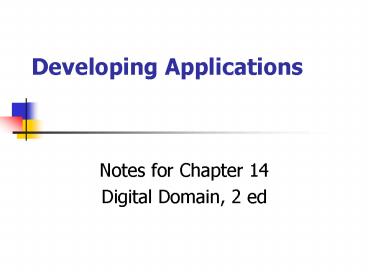Developing Applications - PowerPoint PPT Presentation
1 / 13
Title:
Developing Applications
Description:
Developing Applications Notes for Chapter 14 Digital Domain, 2 ed – PowerPoint PPT presentation
Number of Views:64
Avg rating:3.0/5.0
Title: Developing Applications
1
Developing Applications
- Notes for Chapter 14
- Digital Domain, 2 ed
2
Programming Languages
- Programs consist of sequence of instructions
performed within the fetchexecute cycle - All instructions must be in a particular
processors machine language before that
processor can execute them - machine languages are expressed in binary codes
- assembly languages are symbolic versions of
machine languages - Higher level languages allow programmers to
express a process in a more abstract form (closer
to the actual problem domain) - these high-level languages must be translated
into machine languages - both compiler and interpreter software can be
used to accomplish this translation
3
Programming Languages (contd)
- Programs often employ variables and functions to
accomplish their tasks - Conditional statements alter the flow of control
within the program sequence - allow the program to make decision
- move to different sequences of instructions based
on Boolean conditions (conditions that can be
true or false)
4
Scripting Languages
- Scripting languages are interpreted languages
- Very useful for Web-related programming tasks
- add interactivity to Web pages
- enable interaction with backend databases
5
The Software Development Cycle
- Analyze and understand the problem
- Devise a plan to solve the problem
- Create an executable program that implements the
plan - Test and correct the program
6
Program Plans as Algorithms
- Program plans are expressed as algorithms
- what information is needed?
- what events are needed to process the
information? - how must these events be sequenced?
- Algorithms may be expressed using
- flow charts
- pseudocoding
- Translating an algorithm to an executable program
is called coding
7
Testing and Software Complexity
- Testing involves running a program with the goal
of finding any errors (sometimes called bugs) so
they can be corrected - Large programs are very complex
- testing can rarely uncover all bugs
- beta testing allows program users to help uncover
additional errors after initial testing is
completed - Testing is part of a larger process known as
software quality assurance
8
Software Development is a Team Effort
- Systems analysts planning and design
- Project manager oversee the schedule and budget
- Programmers work in teams to complete the
coding - Quality assurance testing
9
Programming Paradigms
- A programming paradigm defines the basic model by
which a language expresses a process - imperative procedural paradigm
- uses modules called procedures or functions
- examples Pascal, BASIC, FORTRAN, COBOL, C, and
ADA - object-oriented paradigm
- objects encapsulate both data and process
- objects have attributes (data)
- objects have associated methods (process)
- most scripting languages use this paradigm
- examples Java, C, JavaScript, VBScript, and
Visual Basic
10
Programming Paradigms (contd)
- nonprocedural paradigm
- often used in artificial intelligence (AI)
applications - examples Prolog, LISP, and FP
11
Other Programming Languages
- End-user languages
- Languages for Internet applications
- scripting languages
- event-driven programming
- Languages for extending and integrating
applications - visual programming (Visual BASIC)
- AppleScript
- Languages for specialized applications
- Director/Lingo
- Flash/ActionScript
12
Summary
- Programs consist of sequence of instructions
performed within the fetchexecute cycle - All instructions must be in a particular
processors machine language before that
processor can execute them - Higher level languages allow programmers to
express a process in a more abstract form (closer
to the actual problem domain) - The software development cycle consists of
- Analyze and understand the problem
- Devise a plan to solve the problem
- Create an executable program that implements the
plan - Test and correct the program
13
Summary (contd)
- Software development is a team effort
- Systems analysts planning and design
- Project manager oversee the schedule and budget
- Programmers work in teams to complete the
coding - Quality assurance testing
- There are number of programming paradigms
- imperative procedural paradigm
- object-oriented paradigm
- nonprocedural paradigm































